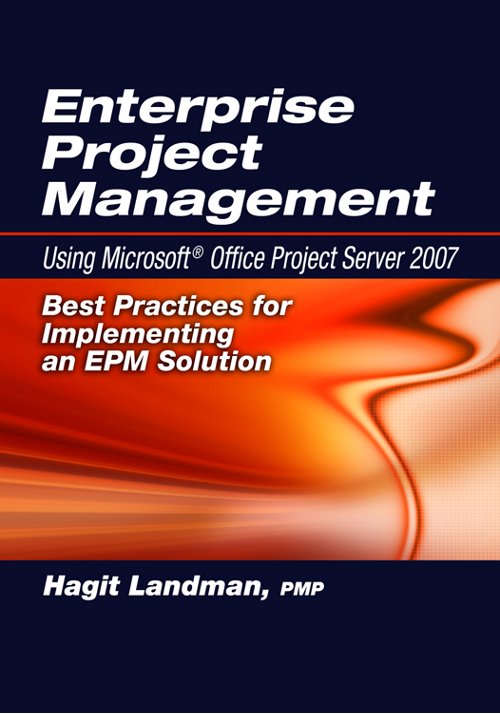Enterprise Project Management Using Microsoft® Office Project Server 2007
$64.95
Best Practices for Implementing an EPM Solution
By Hagit Landman, PMP
Softcover, 7.5 x 9.25, 448 pages
ISBN: 978-1-932159-97-4
July 2008
Description
Enterprise Project Management (EPM) is a methodology that combines standardized project management processes and supporting tools to better meet an organization’s project or program management goals. Microsoft Office Project Server 2007, together with its SharePoint technology, are some of the best EPM supporting tools available. Enterprise Project Management Using Microsoft® Office Project Server 2007 presents an effective EPM methodology that uniquely combines the use of these processes and supporting tools. It takes users step-by-step through each stage of an EPM solution implementation. Based on the author’s extensive experience, it provides the principles, processes, best practices, and detailed instruction needed to define, implement, and deploy an EPM solution in your organization using Office Project Server 2007 and other EPM supporting tools.
Greater visibility, insight, and control across all projects and programs, enhanced decision-making, improved alignment with business strategies, better communication, optimal resource utilization and increased opertional efficiency are among the many benefits of implementing an EPM solution. However, implementing an EPM solution that combines project management methodology and supporting tools to enable all project stakeholders in your organization to perform the defined processes effectively is not a simple task unless there is detailed instruction and guidance based on practical experience. This is the first book to provide instruction on how to implement an EPM solution in an organization based on the Project Management Institute’s standardized processes and how to configure the supporting tools from Microsoft products and solutions. PMO professionals, business analysts, program and project managers, project teams and stakeholders will find this unique manual invaluable.
Key Features
- Illustrates how to implement an EPM solution to better meet an organization’s project or program management goals based on PMI’s proven project management methods using Microsoft’s Project Server 2007, Project Professional, SharePoint Technology and other familiar Microsoft products
- Describes the stages of an EPM implementation and explains how to carry out the tasks needed to achieve the objectives of each stage
- Establishes a technological foundation for development, testing, training, and deployment of an EPM solution, and sets the requirements and goals for the EPM implementation
- Helps align the project management processes with your organization’s goals and defines the procedures and tools required to support these processes
- Includes numerous examples that demonstrate how to configure the EPM system to support your implementation and a pilot testing stage where your solution can be examined for several months before organization-wide deployment
About the author(s)
Hagit Landman, PMP, is a program management consultant with more than 17 years of experience in multi-disciplinary projects, has defined and implemented EPM solutions in several large IT companies and has extensive successful experience at implementing EPM solutions using Microsoft software products. Ms. Landman is an active member of the Project Management Institute and an elected officer of PMI’s Israel Chapter Board of Directors. She has also participated in writing items for both the Program Management Professional (PgMP) and the Certificate Associate in Project Management (CAPM) certification exams administered by PMI. She has an MBA and a Bachelor of Science Degree in Industrial Engineering and Management.
Table of Contents
Part I. EPM Foundation, Goals and Requirements
Chapter 1: Establishing Technology Environments
Overview of the Microsoft EPM System
Setting Up Technological Environments
Obtaining Administrative Rights
Setting Up Project Professional to Work with Project Server
Chapter 2: Organizational Goals, Objectives and Requirements
Defining Organization Goals and Objectives
Understanding Stakeholder Requirements
Part II. Project Management Processes and EPM Solution Deployment
Chapter 3: Establishing Project Management Processes and Supporting Tools
Overview
Definitions
Acronyms
Chapter 4: Initiation Process
Overview
Creating Proposed Project Plan
Creating Project Workspace
Entering Initial Project Information
Performing Preliminary Stakeholder Analysis
Filling Out the Requirements Matrix
Finalizing High-level Milestone Plan
Creating Project Charter
Creating Preliminary Scope Statement
Approving Project for Planning
Chapter 5: Planning Process
Overview
Converting Proposed Project to Project Plan
Associating Project Information with Project Plan
Field-specific Procedures
Building Project WBS
Integration Management – Project Management Plan
Defining Scope Management Plan
Defining the CR Management Process
Defining Time Management Plan
Defining Human Resource Management Plan
Defining Cost Management Plan
Defining Quality Management Plan
Defining Risk Management Plan
Defining Communication Management Plan
Defining Deliverable Management Plan
Defining Procurement Management Plan
Setting Baseline
Chapter 6: Execution Process
Overview
Integration Management – Kick-off Meeting
Scope Management
Cost Management
Quality Management – Quality Assurance
Human Resources Management
Communication Management
Risk Management
Procurement Management
Chapter 7: Monitoring and Control Process
Overview
Scope Control
Time and Schedule Control
Cost Control
Quality Control
Human Resource Management
Communication Management
Risk Control
Procurement – Contract Administration
Chapter 8: Closing Process
Overview
Integration Management
Scope Management
Time Management
Cost Management
Human Resource Management
Communication Management
Risk Management
Procurement Management
Chapter 9: Converting Your Sample Site to Be the Default Project Workspace
Chapter 10: Testing and Deploying Your EPM Solution
Overview: Testing Solution with a Pilot Team/Project
Establish Training Materials
On-Going Support (3 Months)
Pilot Feedback and Lessons Learned
Develop Deployment Plan
Deploying Solution to Organization Units
Appendix A: Common Procedures
Defining Enterprise Custom Fields
Creating Lookup Tables for Enterprise Custom Fields
Creating Document Libraries
Changing Document Library Metadata
Changing Document Library Settings
Uploading Documents to Libraries
Creating Lists
Changing Column Names in Lists
Adding Choice Columns
Adding Yes/No Columns
Adding Text Columns
Adding Columns of Type “Multiple Lines of Text”
Adding Lookup Columns
Adding Number Columns
Adding Currency Columns
Adding Calculated Columns
Adding “Person or Group” Columns
Adding Date Columns
Changing Column Order
Modifying Existing Lists
Creating List Views
Modifying Columns
Creating Folders in Document Libraries
Appendix B: Troubleshooting
Related products
-

ROI of Software Process Improvement
Retail Price: $59.95$49.95 Add to cart -

Aircraft Finance
Retail Price: $99.95$89.95 Add to cart -

Leading High-Performance Projects
Retail Price: $44.95$39.95 Add to cart -

Directing the Flow of Product
Retail Price: $59.95$49.95 Add to cart -

Essential Project Investment Governance and Reporting
Retail Price: $59.95$49.95 Add to cart

